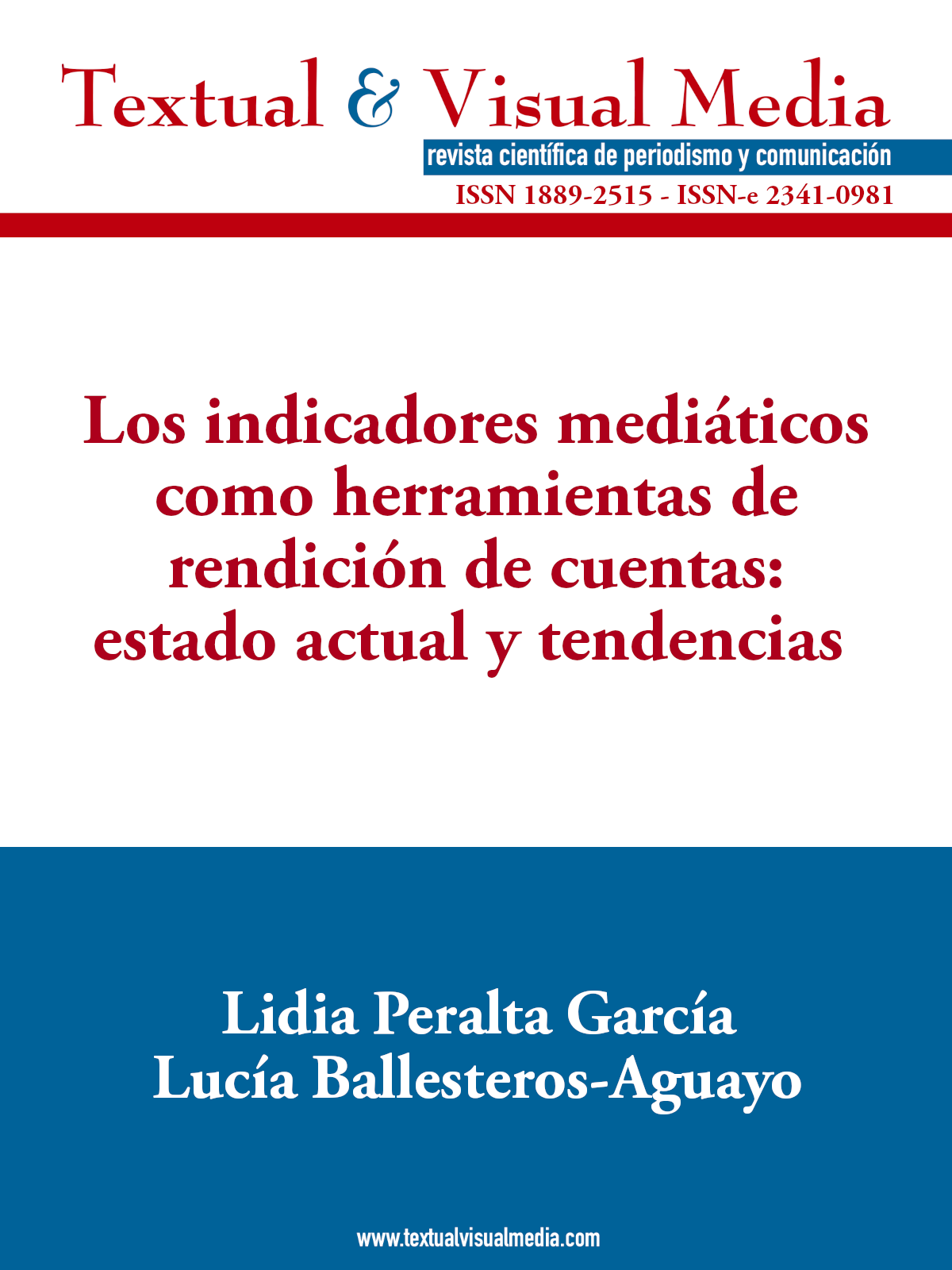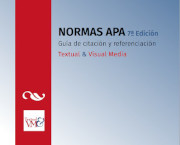Media Indicators as Accountability Tools: Current State of the Art and Trends
DOI:
https://doi.org/10.56418/txt.18.1.2024.3Keywords:
media indicators, measurement, media, information, communication, quality, transparencyAbstract
This paper carries out a literature review on media indicators, as well as other forms of monitoring aimed at 'measuring' media quality. The aim is threefold: a) to contribute to the advancement of knowledge for the establishment of the epistemological foundations of the state of the art; b) to describe the main characteristics of media indicators, highlighting their similarities and differences; c) to identify gaps or areas under development where media indicators could be useful. Methodologically, a snowball review is proposed. The results show that there is a certain dispersion regarding media indicators, which coexists with a trend towards the specialization of these measurement instruments. New thematic niches have been identified that could benefit from the application of indicators, such as the emerging sector of the Ecosocial Transition
Downloads
References
ADECED (2016). La guía práctica de la medición marco de actuación para una buena práctica de la medición en el sector de la comunicación y las relaciones públicas en España. https://shre.ink/8Vgx
AMARC (2010). Principios para garantizar la diversidad y el pluralismo en la radiodifusión y los
servicios de comunicación audiovisual. https://shre.ink/8VgD
Bin Ali, N., y Tanveer, B. (2022). A Comparison of Citation Sources for Reference and Citation-Based Search in Systematic Literature Reviews. e-Informatica Software Engineering Journal, 16(1), pp. 220106. https://doi.org/10.37190/e-Inf220106
Bocova, I. G. (2014, 25 de marzo). On the occasion of the launch of World Trends in Freedom of Expression and Media [Discurso principal]. UNESCO. New York. https://shre.ink/8Vg8
Bucci, E., Chiaretti, M., y Fiorini, A. M. (2012, junio). Indicadores de Desarrollo Mediático: marco para evaluar el desarrollo de los medios de comunicación social. UNESCO, Série Debates CI, (10). https://shre.ink/8Vgr
Campos-Freire, F., y Valencia-Bermúdez, A. (2016). Indicadores de valor para las RTV autonómicas: Rendición de cuentas en EITB, CCMA y CRTVG. Communication & Society, 29(4). https://doi.org/10.15581/003.29.35806
Canadian International Development Agency (1997). Guide to Gender-Sensitive Indicators. https://shre.ink/8VgB
Chaparro, M. (2015). Medios de proximidad: participación social y políticas públicas.
IMEDEA / COMandalucía.
Chaparro, M., Olmedo, S., y Gabilondo, V. (2016). El Indicador de la Rentabilidad Social en
Comunicación (IRSCOM): medir para transformar. CIC. Cuadernos de Información y Comunicación,
, 47-62. https://doi.org/10.5209/CIYC.52944
Cheruiyot, D. K.; Ruto-Korir, R. (2018). The Digital Communication Revolution and Media
Credibility. International Journal of Innovation and Economic Development, 4(2), 19-
Danish International Development Agency (DANIDA) (2005, 1 de octubre). Monitoring and Indicators for Communication for Development. COMMINIT. https://shre.ink/8VbR
De Frutos García, R. A. (2012). Estado del arte para la construcción de indicadores de género en los medios de comunicación. I Congreso Internacional de Comunicación y Género, Universidad de Sevilla y Fundación Tres Culturas. https://shre.ink/8Vga
De Frutos García, R. A. (2014). Mediciones enredadas. La importancia de los indicadores mediático-culturales para el análisis de los sistemas mediáticos. Historia y Comunicación Social, 19, 525-537. https://doi.org/10.5209/rev_HICS.2014.v19.45153
De Frutos García, R. (2015). Indicadores mediáticos: Herramientas para la participación ciudadana y el acceso a la información. Vivat Academia, 130, 141-183. https://doi.org/10.15178/va.2015.130.141-183.
De Charras, D. (2012). Democratizar la comunicación audiovisual en Argentina: una carrera de obstáculos. Revista Sociedad, 113-129.
De Charras, D. (2015). Implementación del sistema de indicadores de calidad de emisoras públicas para la evaluación de la Televisión Pública Argentina. Universidad de Buenos Aires.
Djerf-Pierre, M., y Edström, M. (2020). Comparing Gender and Media Equality Across the Globe: A Cross-National Study of the Qualities, Causes, and Consequences of Gender Equality in and through the News Media. Nordicom (Nordic Council of Ministers, Nordic Information Centre for Media and Communication Research). https://doi.org/10.48335/9789188855329
Duncan, J., y Reid, J. (2013). Toward a measurement tool for the monitoring of media diversity and pluralism in South Africa: A public-centred approach. Communicatio, 39(4), 483-500. https://doi.org/10.1080/02500167.2013.864448
Friedrich-Ebert-Stiftung Foundation (2023). African media barometer A home-grown analysis of the media landscape in Africa. https://shre.ink/8Vg9
Fourie, P. J. (2016). Media Studies Volume 3: Media Content and Media Audiences. E-book. Juta and Company Ltd.
García, R. A. de F. (2013). Indicadores Unesco de género para medios de comunicación. Revista Mediterránea de Comunicación, 4(1), 193–219. https://doi.org/10.14198/MEDCOM2013.4.1.09
Garro Rojas, L., Monge Cordero, A., y Solís Solís, L. (2020). Propuesta de indicadores de desarrollo mediático para Costa Rica. Programa de Libertad de Expresión y Derecho a la Información (PROLEDI). https://shre.ink/8VbP
Gender Links (2022). SADC Gender Protocol Barometer 2022. https://shre.ink/8VbO
Greenhalgh, T. (2005). How to Read a Paper: The Basics of Evidence-Based Medicine. John Wiley & Sons.
Grizzle, A. (2014). Indicadores de género para medios de comunicación. UNESCO. https://shre.ink/8VbY
Gutiérrez, D. (2009). La construcción de indicadores como problema epistemológico. Cinta de
Moebio, (34), 16-36. http://dx.doi.org/10.4067/S0717-554X2009000100002
Harvey, M. H. (2007). Media Matters: Perspectives on Advancing Governance & Development from the Global Forum for Media Development. Global Forum for Media Development. https://doi.org/1010.15868/socialsector.41947
Holtz-Bacher, C. (2004, 25 de julio). What is Good Press Freedom? The Difficulty in Measuring Freedom of the Press Worldwide. International Association for Media and Communication Research, Porto Alegre, Brasil.
IREX. (s. f.). Media Sustainability Index (MSI). https://shre.ink/8Vb4
Jalali, S., y Wohlin, C. (2012). Systematic literature studies: database searches vs. backward snowballing [conferencia]. In Proceedings of the ACM-IEEE international symposium on Empirical software engineering and measurement (ESEM '12). Association for Computing Machinery, New York, NY, USA, 29–38. https://doi.org/10.1145/2372251.2372257
McQuail, D., y Windahl, S. (2015). Communication Models for the Study of Mass Communications. Routledge.
Olmedo, S. (2014). IRSCOM: la responsabilidad social de los medios y la construcción de indicadores
Mediáticos. En Chaparro Escudero, M. (Coord.), Medios de proximidad: participación social y políticas públicas. (pp. 373-400). IMEDEA/ COMandalucía.
Peralta-García L., Sanz-Hernando M. C. y Álvarez-Peralta M. (2022). Estado crítico de las emisoras municipales en Castilla-La Mancha: su gobernanza a través del Indicador de Rentabilidad Social en Comunicación (IRSCOM). Estudios sobre el Mensaje Periodístico, 28(2), 379-390. https://doi.org/10.5209/esmp.70341
Peralta-Garcí¬a, L., Espinar-Medina, L., Chaparro-Escudero, M., y Quijano-Triana, M.-P. (2023).
Adaptation of the Irscom social profitability indicator to the context of community radio in
Colombia. El Profesional De La información, 32(1). https://doi.org/10.3145/epi.2023.ene.19
Pérez Tornero, J. M., y Martínez Cerdá, J. F. (2011). Hacia un sistema supranacional de indicadores mediáticos. Infoamérica ICR, 5, 39-57. https://shre.ink/8VbN
Pérez Tornero, J.M., Giraldo-Luque, S., Tejedor-Calvo, S., y Portalés-Oliva, M. (2018). Propuesta de indicadores para evaluar las competencias de alfabetización mediática en las administraciones públicas. El profesional de la información, 27(3), 521–536. https://doi.org/10.3145/epi.2018.may.06
Puddephatt, A. (2007). Executive Summary of an IPDC paper: Indicators of Media Development. En Jannusch, A. S. (Ed.), Measuring Change Planning, Monitoring and Evaluation in Media and Development Cooperation (pp. 11-15). Catholic Media Council CAMECO. https://shre.ink/8Vbi
Raine, M. (2004). CBA editorial guidelines. The Commonwealth Broadcasting Association with Support from UNESCO. UNESCO. https://shre.ink/8VbC
Romero-Rodríguez, L.-M., de-Casas-Moreno, P., y Torres-Toukoumidis, Á. (2016). Dimensiones e indicadores de la calidad informativa en los medios digitales. Comunicar: Revista Científica de Comunicación y Educación, 24(49), 91-100. https://doi.org/10.3916/C49-2016-09
Sáez, Ch., Avilés, J., Riffo, F., García, J., Jiménez, J., y Breull, L. (2022). Medición del pluralismo informativo en la TV chilena: propuesta y resultados de aplicación de un instrumento multidimensional de análisis. Estudios sobre el Mensaje Periodístico, 28(2), 391-404. https://doi.org/10.5209/esmp.76616
UNESCO. (2008). Indicadores de desarrollo mediático: Marco para evaluar el desarrollo de los medios de comunicación social (CI/COM/2008/PI/3; Intergovernmental Council of the International Programme for the Development of Communication, 26th, Paris, 2008 [21]). https://shre.ink/8Vbv
Unión Europea (2005, 13 de diciembre). El Consejo Europeo extraordinario de Lisboa (marzo de 2000): Hacia la Europa de la innovación y el conocimiento. https://shre.ink/8Vbu
White, A. (2009). Instalar el equilibrio: Igualdad de género en el periodismo. Federación Internacional de Periodistas. https://shre.ink/8Vbj

Published
How to Cite
Issue
Section
License
Copyright (c) 2024 Textual & Visual Media

This work is licensed under a Creative Commons Attribution-NonCommercial-ShareAlike 4.0 International License.






















